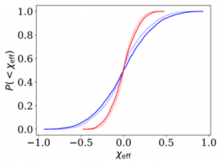
Abstract
Accretion disks around supermassive black holes are promising sites for stellar mass black hole (BH) mergers detectable with LIGO as well as for intermediate and extreme mass ratio mergers detectable with LISA. Here we present the results of Monte-Carlo simulations of BH mergers within 1-d AGN disk models. For the spin distribution, we find: (1) The distribution of χeff from BH mergers in the disk bulk is centered around χ~eff≈0.0, (2) χ~eff is slightly negative if gas hardening of retrograde binaries is more efficient than for prograde binaries, (3) the χeff distribution is significantly narrower for narrow spin magnitude distributions. For the mass distribution, we find: (4) merger mass ratios in the bulk disk have q~∼0.5−0.7, (5) a BH IMF consistent with Galactic BH masses yields q~∼0.7, (6) maximum merger mass in the bulk is ∼102M⊙ and (7) ≤1% of bulk mergers involve BH >50M⊙. Additionally, (8) mergers in a migration trap grow an IMBH, (9) trap mergers are asymmetric, with q~∼0.1. Finally, (10) the majority (≃80%) of mergers are pairs of 1st generation BHs, with a small admixture of hierarchical mergers. (11) Trap mergers are almost entirely hierarchical and (12) The rate of black hole mergers is highest early on in the AGN disk lifetime (≤0.1Myr). Ongoing LIGO non-detections of black holes >102M⊙ puts strong limits on the presence of migration traps in AGN disks (and therefore AGN disk density and structure) as well as median AGN disk lifetime. The highest merger rate occurs for this channel if AGN disks are relatively short-lived (≤1Myr) so multiple AGN episodes can happen per Galactic nucleus in a Hubble time.